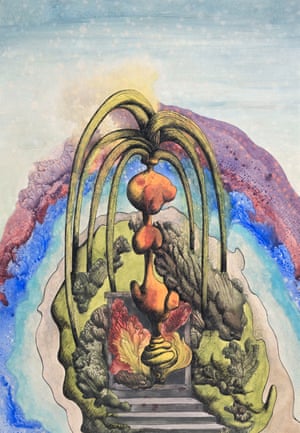[ad_1]
Her name has largely slipped through the gaps of art history, and those who do know her work may associate her primarily with magic and the occult – but, with the acquisition of a huge archive, Tate is hoping that the artist Ithell Colquhoun will finally get the credit and recognition she deserves as a major figure in British surrealism.
Tate has announced that more than 5,000 sketches, drawings, and commercial artworks by Colquhoun have been transferred to it by the National Trust.
Her name and reputation is little known but it deserves to be, said Tate archivist Adrian Glew. “She had very few solo exhibitions … that’s why this collection is so amazing – it is going to be a re-evaluation of her whole career because there is so much in the collection.”

Colquhoun was born in 1906 and, as sketchbooks in the archive show, was a talented artist from a young age. She studied at the Cheltenham School of Arts and Crafts and the Slade in London, after which she moved to Paris and discovered, to her joy, the world of surrealism.
She also had a life-long preoccupation with magic, mythology and the occult. Her reluctance to give up that interest created tensions with other artists, and she left the British Surrealist group in 1940.
But, as the archive shows, she was a prodigious and inventive surrealist all her life.
There are many examples of the diverse number of techniques she used in her art, such as fumage, the process of using a candle to make abstract shapes on the paper; and decalcomania, which involved folding paint within the paper.
The collection provides a complete record of her experiments with surrealist automatism, a method where the artist surrenders artistic control over the process.
Glew said the acquisition provided “the most comprehensive collection of examples of surrealistic techniques we have now in the archive”.
Colquhoun lived for much of her life in an unheated house in Cornwall. When she died in 1988, she left her occult work to Tate, and the rest of her artistic belongings to the National Trust.
Glew said it made much more sense for both to be together as one archive, so that previously divided items illuminating her ideas and practice can be seen in one place.
The archive from the National Trust, for example, includes an early sketch she made for her 1938 painting Scylla, which is on display at Tate Britain. It is a surreal seascape, but also an image of the artist’s view while looking down at her legs in the bath. The Trust has also given Tate some of Colquhoun’s paintings.

David Taylor, head curator of paintings and sculpture at the National Trust, said he took great pride from the transfer. “As well as Colquhoun being better represented at Tate, the great public benefit of this collaboration between our two organisations is that new generations of scholars and visitors alike will be able to discover and appreciate this important British surrealist.”
Ann Gallagher, director of Tate’s British art collection, said she was delighted, calling Colquhoun “one of the key figures of British surrealism”.
More than 67,000 items in the Tate archive are digitised and Glew said the hope was to add Colquhoun’s items to that number and, in turn, prompt a greater interest and knowledge of the artist.
“We estimate that there are around 5,000 items, which makes it the largest study collection relating to one artist in the archive,” he added.
[ad_2]
READ SOURCE


